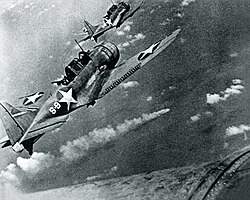
The Battle of Midway is largely regarded as the most important naval battle of the Pacific Campaign of World War II. Between 4 and 7 June 1942, approximately one month after the Battle of the Coral Sea and seven months after Japan's attack on Pearl Harbor, the United States Navy decisively defeated an Imperial Japanese Navy (IJN) attack against Midway Atoll, inflicting irreparable damage on the Japanese navy and seizing the strategic initiative.
The Japanese operation, like the earlier attack on Pearl Harbor, aimed to eliminate the United States as a strategic Pacific power, thereby giving Japan a free hand in establishing its Greater East Asia Co-Prosperity Sphere. It was hoped another demoralizing defeat would force the U.S. to negotiate an end to the Pacific War on conditions favorable to Japan.
The Japanese plan was to lure the United States' few remaining carriers into a trap. The Japanese also intended to occupy Midway Atoll as part of an overall plan to extend their defensive perimeter in response to the Doolittle Raid. This operation was considered preparatory for further attacks against Fiji and Samoa. The plan was handicapped by faulty Japanese assumptions of American reaction and poor initial dispositions.
American codebreakers were able to determine the date and location of the attack, enabling the forewarned U.S. Navy to set up an ambush of its own. Four Japanese aircraft carriers and a heavy cruiser were sunk in exchange for one American aircraft carrier and a destroyer. The heavy losses, particularly the four fleet carriers and their aircrews, permanently weakened the Imperial Japanese Navy. Japan was unable to keep pace with American shipbuilding and pilot training programs in providing replacements.
(more...)